AFP, HARBIN, China
Animal ears and pom-poms on fuzzy hats adorn tourists’ heads on the streets of the frigid northeastern Chinese city of Harbin, which is enjoying a surge in visitors driven by social media.
Photographs and videos taken at the city’s landmarks flood platforms such as TikTok counterpart Douyin and Instagram-esque Xiaohongshu — many featuring tourists from the warmer south.
They are affectionately known as “southern little potatoes,” a reference to their alleged smaller stature and cutesy winter gear that contrast with the area’s stereotypically coarse character.

A woman gestures at a tourist spot in Harbin, China, on Dec. 17 last year.
Photo: AFP
A search for “southern little potatoes visit the north” racked up more than 428,000 notes on Xiaohongshu.
That is where Chen Xiting, who works in e-commerce in southern Guangdong Province, said she was inspired to visit.
“It’s the quickest way young people get trip recommendations,” Chen said.

People visit the Harbin Ice and Snow World Festival in the Chinese city on Dec. 21.
Photo: AFP
She said she had noticed a sizeable number of fellow southerners.
“I heard quite a bit of Cantonese, which we’re very familiar with, today at tourist sites and on the street,” said the 29-year-old, wearing a hat with dog ears and with only her face exposed to the air.
Liu Rong, a student from Sichuan Province, said that the city’s push for more southern tourists was clear from the surge in videos about Harbin he often watched with his wife.
“These years, especially this year, Harbin’s cultural tourism has placed a lot of importance on paying attention to us southerners,” Liu said.
Harbin is the capital of Heilongjiang, one of three provinces that make up the Dongbei (northeast) region, where temperatures can reach minus-30°C during winter.
Bordered by Russia and North Korea, it is one of China’s poorest provinces, but the first five months of last year saw the operating income of Heilongjiang’s cultural, sports and entertainment industries rise nearly 60 percent year-on-year, official data showed.
Tourists spent 154 billion yuan (US$21 billion) in the first half of last year, up 171 percent from the first half of 2023.
Popular novels and dramas set in the northeast have also helped spark a travel boom to the region.
“A lot of southerners, who we call ‘little potatoes,’ came over here for travel and made our Harbin very trendy,” said Emily Liu, a local tour guide.
The online fame has been good for the travel business, said 30-year-old Jiang Zhonglong, energetically gesticulating in front of his tripod just meters away from Liu.
He started working for a Harbin-based travel agency three years ago, during the COVID-19 pandemic, and said business was now much better.
“So many little friends, southern potatoes, tourists have all come here,” he said.



